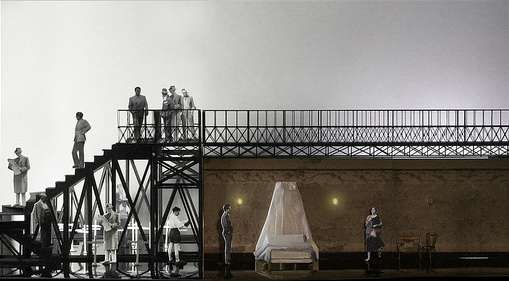|
Back
New Twist on an Old Story Palm Beach
Kravis Center for the Performing Arts
02/24/2012 - & February 25, 26, 2012
Charles Gounod: Roméo et Juliette
Arturo Chacón-Cruz (Roméo), Nicole Cabell (Juliette), David Adam Moore (Mercutio), Jennifer Rivera (Stephano), Alexander Vinogradov (Frère Laurent), Shirin Eskandandi (Gertrude), Evanivaldo Correa Serrano (Tybalt), Grigory Soloviov (Count Capulet), R. Kenneth Stavert, (Gregorio), Jesse Enderle (Paris), Benjamin Clements (The Duke)
Palm Beach Opera and Chorus, Greg Ritchey (chorus master), Will Crutchfield (conductor)
Kevin Newbury (director), Allen Moyer and Laura Jellinek (scenic design), Paul Carey (costume design), D. M. Wood (lighting design)

(Courtesy of Palm Beach Opera )
Gounod’s Roméo et Juliette is never quite on the A-list of the most performed. It is barely on the B-list though opera companies have box-office success with it simply because of the title. The opera itself is long and at times quite lugubrious. Unquestionably there is some beautiful stuff though probably too many duets for the sacred couple. And that sanctity of them is part of the problem. Yes, it is romantic, but there is never any sexiness in the score and you would think the French could have handled that. In fact this story never seems to give composers inspiration to deal with teenage sexuality though Prokofiev was truly erotic with his ballet score.
But just because this might be one’s opinion of the opera, that doesn’t mean that it cannot be a very rewarding evening if the singers, orchestra and director approach it with enough spunk. And this is a time when we got just that.
Director Kevin Newbury decided to offer a production updated to a time shortly after WW2. The costumes give a sort of West Side Story feel but the ambience might seem closer to The Saint of Bleeker Street; urban Italian Catholicism is laid on pretty heavy with each member of the chorus standing over a cross, throughout the prologue, which they then carry offstage to reuse intermittently. The cast looks dressed not just for a big dance but more as if they have first been to mass; except for Juliette who is ebullient in yellow taffeta.
The interesting set is mainly a platform with an iron stairway which might make some think of the fire escape on Maria’s tenement. Suitable backdrops are placed behind and below it offering strikingly memorable settings. Though this re-creation might not work for those who want to luxuriate in Shakespeare’s lusty tragedy, others will find the drama much more immediate. In this production the characters of Roméo and Juliette, rejecting rules of their society, exhibit people who are not only in love, but are heroic and self-respecting. Does everything work in this production? Of course not, any updating usually makes a compromise regarding society norms and traditions. In this production Juliette’s tomb is what looks like a hospital bed. No one would have placed his or her deceased child in anything but a coffin by the 20th century. And leaving her bed for her final duet still in her white high heels can look pretty alarming.
The length of this opera is its biggest drawback; the librettists, Jules Barbier and Michel Carré didn’t seem to know where to make cuts to the story. But in truth, the plot was always pretty tight and drastic cutting would create incoherence, though the final death scene’s repetition couldn’t help but create quite a few snickers before the lovers finally expired.
But a good physical production is only a small part of any piece of worthwhile theatre. In opera if the lead singers are not able to deliver the goods, no amount of clever design or great choreography can make the evening involving. This might be especially true in Roméo et Juliette where appropriate physical casting is as essential as vocal.
Arturo Chacón-Cruz sang Roméo through to the first intermission with a pronounced tremolo. It did not at all distract from his beautiful sound. The affectation was not noticeable during the dramatic third act but could be heard intermittently in the last two. Whatever the case, his is a thrilling hero and he was easily the star of the evening. Nicole Cabell is a modern Juliette; no weepy willow but a very strong and determined young woman who understands how she must compromise in a culture stacked against her gender. Cabell’s voice is sumptuous and strong; her duets with Chacón-Cruz were, to be blunt, scorching.
Alexander Vinogradov appeared too young to be a convincing Frère Laurent but his beautiful booming bass was particularly moving, especially in the wedding ceremony. Jessica Rivera can do something that few females do in trouser roles, really moving like a boy and her gorgeous assured mezzo makes the brief role of Stephano a knockout resembling one of the Dead End kids. Bring on her Cherubino! David Alan Moore ran out of breath at the climax of his phrases making little impact with the Queen Mab aria.
French opera requires a subtle reading that Will Crutchfield along with the Palm Beach Opera Orchestra gave with tremendous elegance.
There might be a camp of traditionalists who are wondering where the money was spent, but after this, adventuresome theatregoers might begin to better appreciate a work that has often eluded them. Most certainly this was not a performance one will forget soon.
Jeff Haller
|